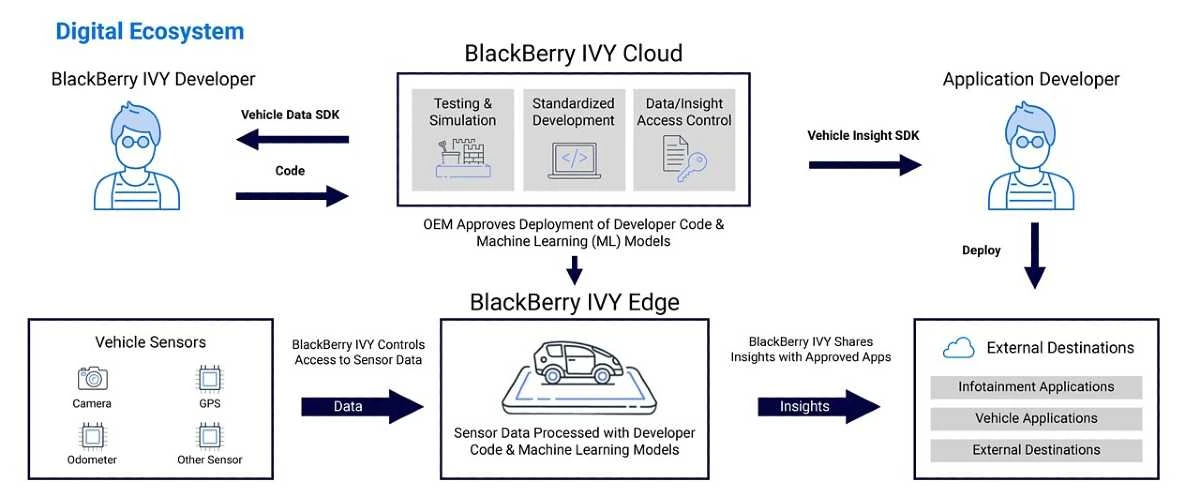BlackBerry has established the BlackBerry IVY Innovation Fund to help data-driven automotive ecosystem providers turbocharge their innovation and bring new products and applications to market using BlackBerry’s Intelligent Vehicle Data Platform, BlackBerry IVY.
Announced in December 2020 as part of a multi-year, global agreement with Amazon Web Services (AWS), BlackBerry IVY is a scalable, cloud-connected software platform that will allow automakers to provide a consistent and secure way to read vehicle sensor data, normalize it, and create actionable insights from that data both locally in the vehicle and in the cloud. Automakers can use this information to create responsive in-vehicle services that enhance driver and passenger experiences.
The BlackBerry IVY Innovation Fund’s mission is to accelerate the expansion of the BlackBerry IVY ecosystem with innovative transportation solutions. The Fund will initially allocate up to $50 million to invest in startups focused on developing data-driven solutions that can benefit from BlackBerry IVY’s AI insights and support from BlackBerry and AWS.
The BlackBerry IVY Innovation Fund will provide portfolio companies with access to BlackBerry’s strong automotive and cybersecurity domain expertise. They will also have access to up to $100,000 in AWS credits through AWS Activate, a program that has helped hundreds of thousands of early stage startups accelerate their growth and development. This includes access to the Activate Console, a self-service platform that connects startups to insights, technical guidance, and more to help them build their businesses.
BlackBerry says that the BlackBerry IVY Innovation Fund underscores BlackBerry’s commitment to developing the BlackBerry IVY ecosystem to allow OEMs, smart mobility providers, fleet operators, and developers alike to leverage the rich insights from the next generation of intelligent connected vehicles.
“The connected vehicle market is evolving with a tremendous rate of innovation. BlackBerry IVY has the potential to play a pivotal role in enabling a rich ecosystem of solutions that improve and enhance driver and passenger experiences and ultimately revolutionize the way we get from A to B,” said Vito Giallorenzo, SVP Corporate Development & Strategic Partnerships, BlackBerry.
“The BlackBerry IVY Innovation Fund will be a powerful tool to enable both established and startup partners to benefit from BlackBerry IVY’s powerful data insights and help us drive advancements across the entire transportation industry.”
BlackBerry will allow automakers to provide a consistent and secure way to read vehicle sensor data, normalize it, and create actionable insights from that data both locally in the vehicle and in the cloud.
Automakers can use this information to create responsive in-vehicle services that enhance driver and passenger experiences.
“BlackBerry IVY is reinventing the automotive customer experience by transforming vehicles from fixed pieces of technology into systems that grow and adapt with a user’s needs,” said Sarah Cooper, General Manager of Outcome Driven Engineering at Amazon Web Services.
“The BlackBerry IVY Innovation Fund is an important step in creating the community of developers and inspiring the ingenuity from startups that will drive innovation forward.”

BlackBerry IVY addresses a critical data access, collection, and management problem in the automotive industry. Modern cars and trucks are built with thousands of parts from many different suppliers, with each vehicle model comprising a unique set of proprietary hardware and software components.
These components, which include an increasing variety of vehicle sensors, produce data in unique and specialized formats. The highly specific skills required to interact with this data, as well as the challenges of accessing it from within contained vehicle subsystems, limit developers’ abilities to innovate quickly and bring new solutions to market.
BlackBerry IVY will solve for these challenges by applying machine learning to that data to generate predictive insights and inferences, making it possible for automakers to offer in-vehicle experiences that are highly personalized and able to take action based on those insights.
BlackBerry IVY will support multiple vehicle operating systems and multi-cloud deployments in order to ensure compatibility across vehicle models and brands. It will build upon BlackBerry QNX’s capabilities for surfacing and normalizing data from automobiles and AWS’s broad portfolio of services, including capabilities for IoT and machine learning.
BlackBerry IVY will run inside a vehicle’s embedded systems, but will be managed and configured remotely from the cloud. As a result, automakers will gain greater visibility into vehicle data, control over who can access it, and edge computing capabilities to optimize how quickly and efficiently the data is processed.
With BlackBerry IVY’s integrated capabilities, automakers will be able to deliver new features, functionality, and performance to customers over the lifetime of their cloud-connected vehicles, as well as unlock new revenue streams and business models built on vehicle data.
For instance, BlackBerry IVY could leverage vehicle data to recognize driver behavior and hazardous conditions such as icy roads or heavy traffic and then recommend that a driver enable relevant vehicle safety features such as traction control, lane-keeping assist, or adaptive cruise control.
IVY could then provide automakers with feedback on how and when those safety features are used, allowing them to make targeted investments to improve vehicle performance.
Additionally, drivers of electric vehicles could choose to share their car’s battery information with third-party charging networks to proactively reserve a charging connector and tailor charging time according to the driver’s current location and travel plans.
BlackBerry IVY could also provide insights to parents of teenage drivers who may choose to receive customized notifications based on insights from vehicle sensors when the number of passengers in the vehicle changes, when the driver appears to be texting, distracted, or not observing speed limits, or when the vehicle occupancy level rises above the parents’ desired safety threshold.
Similarly, parents of infants could receive a reminder to engage the child safety lock when the vehicle detects a child in the rear seat.
BlackBerry IVY will enable automakers to compress the timeline to build, deploy, and monetize new in-vehicle applications and connected services across multiple vehicle brands and models.
Instead of investing in one-off solutions that conform to the unique engineering of different vehicle models (as they do today), automakers using BlackBerry IVY will be able to leverage different types of data as common building blocks for new services that could work across a range of models.
Automakers will be able to use the platform’s application programming interfaces (APIs) to share data and outputs with their software development teams, giving them the ability to innovate, while also protecting customer privacy and security by controlling whom can access vehicle and app data and at what level of detail.
In addition, BlackBerry IVY will make it easier for automakers to collaborate with a wider pool of developers to accelerate creation of new offerings that deliver improved vehicle performance, reduced costs for maintenance and repairs, and added convenience.
For instance, by analyzing real-time performance data, automakers could recognize the first signs of potentially faulty parts, deploy code to identify affected vehicles, notify impacted drivers, and perform targeted recalls.
Automakers will be able to remotely deploy and update the software from the platform’s Cloud Console (a web interface for managing BlackBerry IVY) to continuously improve the functionality of the system.



